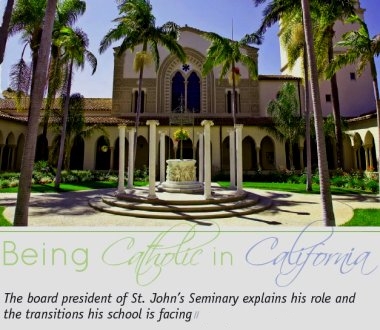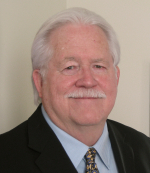
Since 2003, Patrick Nichelson has served on the board of St. John's Seminary in Camarillo, California.
 |
F. Patrick Nichelson
Courtesy Jean O'Sullivan |
Founded in 1939 by the Archdiocese of Los Angeles, St. John's sits on a hilltop 50 miles west of downtown Los Angeles. The seminary provided both undergraduate and graduate-level theological education until 2003, when the undergraduate school was closed. Today, St. John's is a graduate-level institution that prepares future priests for dioceses in the southwestern United States.
Nichelson attended St. John's from 1959 to 1965 before going on to a secular career as a professor of religious studies at California State University, Northridge (CSUN). He has served as chair of the department of religious studies and the faculty senate at CSUN and he's been statewide president of the California Faculty Association. He also has experience in community college governance, having been a public member (and chair) of the board of Santa Monica College, a two-year institution with more than 30,000 students.
This year Nichelson retired from CSUN after 40 years on the faculty. Now professor emeritus of religious studies, he is a board member of the San Fernando Valley Interfaith Council and is a public member of the National Board of Certification in Emergency Medicine for the American Association of Physician Specialists.
The big picture
How many students are at St. John's?
We offer three degrees: a master of divinity, an academically focused M.A. degree, and a master of arts in pastoral ministry. There are about 75 seminarians working toward an M.Div. and ordination. There are also 29 lay people, mostly women, who are training for ministerial programs.
Who funds the seminary?
The archdiocese, the Doheny Endowment (which provides education for Los Angeles archdiocesan priests), and a handful of other smaller endowments. There are also enrollment fees, tuition payments for candidates from other dioceses or religious orders, and lay students.
Preparing for leadership
What has prepared you for your role on the board?
Since so much of my work has been in Catholic studies, that background gives me a head start compared to some board members. For one thing, I understand what they're talking about when they mention seminarians' intellectual or academic formation.
I'm not saying that every board leader should be an academic, but it does have its advantages when the faculty or the rector is presenting material about formation. And I understand the four pillars of formation, which is the guide for all American Catholic seminaries these days.
What are the four pillars of a Catholic seminarian's formation?
The four pillars are enumerated in the Program of Priestly Formation, a document from the American bishops based on guidelines from Rome. The four pillars are human, spiritual, intellectual, and pastoral formation.
Human formation is considered the basic pillar and requires great attention to the availability of counseling services and advisement. Everybody has his own formation director, and we focus a lot on the psychological, emotional, and cultural formation of these men.
Because we are in the Southwest, great attention is focused on cultural backgrounds. St. John's students are extremely diverse. Working through all that diversity is a very important part of moving towards the priesthood.
This even affects how the seminary's food operation works. There's a great diversity of food — there's Asian food, Mexican food, African food. And the faculty is very attentive to the living quarters. People from some cultures want to be more alone, while from other cultures they want to live more communally. Many things that you could ignore until modern times have to be considered. I think it's a very hopeful trend in seminary education, because these guys are going to be out there working in an extremely diverse society.
In your career at Cal State Northridge, you were a strong faculty advocate. Has that affected your leadership at the seminary?
This small faculty is a highly dedicated workforce. Perhaps I have a greater respect for the challenges they're up against, with their modest salaries and rather phenomenal workloads. Their academic quality is just outstanding.
What is the typical course of study at St. John's?
Two years of pre-theology, if they haven't already done philosophy and a lot of religious studies. And then four years of theology. Language studies run throughout the whole six years. Typically, between the second and third years of theology, they go off for an academic year to be interns in parishes.
The faculty oversee the internship program, because they want it to be as effective and profound as possible. It's pretty elaborate. The staff that run that internship program drive all over Southern California, going to these parishes to make sure things are working.
Governance at a Catholic seminary
As a Catholic diocesan seminary, your governance model is somewhat unusual. For example, Cardinal Mahony acts as board chair, right?
Yes. Under our bylaws, the ordinary of the diocese, Cardinal Roger M. Mahony, is the "corporate sole." So, it is his seminary and he is chair of the board. [Editor's note: In Catholic usage, an "ordinary" is a bishop who has jurisdiction over a diocese, as opposed to an auxiliary bishop or retired bishop, who does not have jurisdiction.]
He makes the ultimate decision on matters of policy?
That's right, but he works very collaboratively with the board. I think that's the norm these days — most modern bishops work collaboratively with their boards.
How often does the board meet?
Four times a year. Formally, the board meets only once a year with the cardinal.
Cardinal Mahony is retiring soon. What challenge does that present?
We're not sure of the impact yet, but it will happen in 2011. His successor, Jose Gomez, former archbishop of San Antonio, has been chosen and is now coadjutor archbishop of Los Angeles, which means he'll succeed Cardinal Mahony as soon as the cardinal retires.
How do you envision the transition?
We're confident that our relationship with Archbishop Gomez will very collaborative, as is our relationship with Cardinal Mahony. Archbishop Gomez' prior work - and his writing - show that he's deeply committed to high-quality priestly formation.
Have you been preparing your board for this new leader?
We just had a board retreat partly focused on change, but without knowing the future we didn't actually get into any specifics. But the rector, Msgr. Craig Cox, is a strong leader who has worked very closely with Cardinal Mahony. He was just reappointed as rector during the transition.
Describe your board.
We have eight priests and a nun. And we have eight laywomen and seven laymen.
The current board vice president is a priest. The treasurer is a businessman. Elizabeth Patterson, a Presbyterian, is board secretary and has played a strong role on the board. She was a faculty member and also has been in administration at Fuller Seminary in Pasadena. She's also been an ATS accreditation reviewer and visitor for both Protestant and Catholic seminaries.
What are the active committees?
We have three committees: ministerial formation, finance, and institutional advancement.
Your budget is about $5.3 million. Are you finding it challenging to meet the budget?
Yes. We're watching the budget every quarter. We have old buildings that need maintenance.
In 2003, we closed St. John's College, which is physically located on the seminary campus. We had a real estate company poised to sell that land for expensive homes, to help our endowment. But the sale is on hold until the real estate market recovers.
Accreditation
Your board is in the middle of reaccreditation, correct?
The Western Association of Schools and Colleges (WASC) and the Association of Theological Schools (ATS) have both been intensively reviewing the seminary during my time on the board. Because of my academic background, I come with a certain amount of experience — but also sympathy for a small theological school with a faculty of 23 and a support staff of 40. Accreditation is pretty much the same process whether it is a large or small school. It's so elaborate. And I've worked with WASC as a community college trustee and a university professor.
The three stages of re-accreditation began a year and a half ago. We wrote a proposal about what we want to do and what we want to prove we're doing. Then we had a capacity preparatory review, a big self-study, to demonstrate that we had the capability to accomplish our goals. The accreditation visitors met with select members of the board. Some meetings broke off into subgroups, depending on the interest of the visitors.
The last stage is a very in-depth assessment — more than I've ever seen anywhere else. Board members are on call in case the accreditors want to talk with us.
Do the accreditors meet with the ordinary as chair of the board?
Yes. The accreditors have had intimate meetings with Cardinal Mahony at the important stages. I'm sure they ask if he can afford to keep supporting it. They have also met with Archbishop Gomez, and I have no doubt that question came up again, because it's a question all seminaries are asking.
The meetings with the ordinary highlight the Roman Catholic diocesan governance model.
The accreditors recognize the difference right away. They all know that the board is involved, but when they really want to know what we have, they ask the ordinary of the archdiocese.
Wisdom
What would you like to tell other board leaders?
First, I think it is a vital thing for our society that there be well-prepared clergy. But the economic odds are against us.
Second, we're preparing people for one of the hardest jobs in the world. One of the things I really admire about St. John's is the increased focus on the emotional and multicultural formation of the candidates. I suspect that is true in many institutions.
Third, if In Trust readers visit St. John's they'll find it rewarding both intellectually and spiritually.
QUICK FACTS
St. John's Seminary
Location:
Camarillo, California — 50 miles west of downtown Los Angeles
Administration:
Msgr. Craig Cox has been rector-president since 2007.
Governance:
A board of directors with five officers, 16 regular members, three observers from the faculty and student body, and on nonvoting ex officio member from the archdiocesan office.
Corporation sole:
Like most Catholic diocesan seminaries St. John's is a "corporation sole," and the archbishop of Los Angeles is the "corporate sole," the single legal owner, who passes authority to his successor in office. At St. John's, the archbishop also serves as chair of the board of directors, which is legally an advisory group, not a board of trustees with final authority. Patrick Nichelson is president of the board.
History:
In 1927, rancher Juan Camarillo donated 100 acres of his vast landholdings near Ventura to the archdiocese. He specified that a seminary dedicated to St. John the Evangelist was to be built on the hilltop site. Ground was broken for the new seminary in 1938.